| Demographics of Belfast | |
|---|---|
 Population pyramid of Belfast | |
| Population | 345,418 (2021) |
The city of Belfast is the provincial capital of Northern Ireland. The population of the Belfast Local Government District was 345,418 in 2021.
| Demographics of Belfast | |
|---|---|
 Population pyramid of Belfast | |
| Population | 345,418 (2021) |
The city of Belfast is the provincial capital of Northern Ireland. The population of the Belfast Local Government District was 345,418 in 2021.
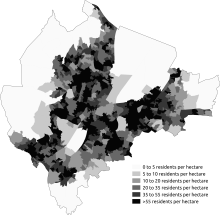
| Year | Pop. | ±% p.a. |
|---|---|---|
| 1757 | 8,549 | — |
| 1782 | 13,105 | +1.72% |
| 1791 | 18,320 | +3.79% |
| 1806 | 22,095 | +1.26% |
| 1821 | 37,277 | +3.55% |
| 1831 | 53,287 | +3.64% |
| 1841 | 75,308 | +3.52% |
| 1851 | 97,784 | +2.65% |
| 1861 | 119,393 | +2.02% |
| 1871 | 174,412 | +3.86% |
| 1881 | 208,122 | +1.78% |
| 1891 | 255,950 | +2.09% |
| 1901 | 349,180 | +3.15% |
| 1911 | 386,947 | +1.03% |
| 1926 | 415,151 | +0.47% |
| 1937 | 438,086 | +0.49% |
| 1951 | 443,671 | +0.09% |
| 1961 | 415,856 | −0.65% |
| 1966 | 398,405 | −0.85% |
| 1971 | 362,082 | −1.89% |
| 1981 | 314,270 | −1.41% |
| 1991 | 279,237 | −1.17% |
| 2001 | 277,391 | −0.07% |
| 2006 | 267,374 | −0.73% |
| 2011 | 286,000 | +1.36% |
| 2021 | 293,298 | +0.25% |
| [1] [2] [3] [4] [5] [6] [7] | ||
The total population of Belfast Local Government District was 345,418 in 2021, an increase of 3.5%. [8] [9]
In 2021, 51% of the population was female while 49% was male. [8]

The age demographics of Belfast is different to the rest of the constituent country, 18% were aged 0 to 14, 37% aged 15 to 39, 30% aged 40 to 64 and 15% aged 65 and above. [8]


Belfast has become in recent decades an ethnically diverse city[ clarification needed ], although this ethnic diversity is not to the same scale as other cities across the United Kingdom. Previously, the city was exclusively white (categorised as a simplified ethnic group within Northern Ireland) at 98% white in 2001, however by 2021, this had dropped down to 93%. [8]
| Ethnic group | 2001 [10] | 2011 [11] | 2021 [12] [13] | |||
|---|---|---|---|---|---|---|
| Number | % | Number | % | Number | % | |
| White: Total | 324,775 | 98.8% | 323,090 | 96.8% | 321,666 | 93.1% |
| White | 324,475 | 98.7% | 322,813 | 96.7% | – | – |
| White: British/Irish/Northern Irish only (national identity) and Christian/no religion/religion not stated (religion) | – | – | – | – | 303,252 | 87.8% |
| White: Other | – | – | – | – | 17,801 | 5.2% |
| White: Irish Traveller/White Gypsy | 300 | 277 | 299 | |||
| White: Roma | – | – | – | – | 314 | |
| Asian or Asian British: Total | 2,181 | 0.6% | 7,208 | 2.2% | 12,908 | 3.7% |
| Asian/Asian British: Indian | 461 | – | 2,330 | 0.7% | 4,361 | 1.3% |
| Asian/Asian British: Pakistani | 187 | – | 258 | – | 492 | |
| Asian/Asian British: Bangladeshi | 68 | – | 210 | – | – | – |
| Asian/Asian British: Chinese | 1,383 | 0.4% | 2,378 | 0.7% | 4,738 | 1.4% |
| Asian/Asian British: Filipino | – | – | – | – | 1,637 | |
| Asian/Asian British: Asian Other | 82 | – | 2,032 | 0.6% | 1,680 | |
| Black or Black British: Total | 320 | – | 1,334 | 0.4% | 4,640 | 1.3% |
| Black or Black British: Caribbean | 67 | – | 95 | – | – | – |
| Black or Black British: African | 168 | – | 1,074 | 0.3% | 4,127 | 1.2% |
| Black or Black British: Other | 85 | – | 165 | – | 513 | |
| Mixed: Total | 837 | – | 1,599 | 0.5% | 4,159 | 1.2% |
| Other: Total | 504 | – | 640 | – | 2,046 | 0.6% |
| Other: Any other ethnic group | – | – | – | – | 1,032 | |
| Other: Arab | – | – | – | – | 1,014 | |
| Ethnic minority: Total | 3,842 | 1.2% | 10,781 | 3.2% | 23,753 | 6.9% |
| Total | 328,617 | 100% | 333,871 | 100% | 345,419 | 100% |
84% of Belfast was born within Northern Ireland, 4% within England, less than 1% for Scotland and Wales, 2% within the Republic of Ireland and 10% from other countries. [8]
43% of Belfast has a UK passport only, 29% has a Republic of Ireland passport only, 6% has both UK and RoI (Republic of Ireland) passports, 8% have other passports and 14% have no passport. [8]
Similarly to the trend across all of Northern Ireland, the Protestant population within the city has been in decline, while the non-religious, other religious and Catholic population has risen. In 2021, the proportion of residents who identified as Catholic was 43%, 12% Presbyterian, 8% for the Church of Ireland, 3% Methodist, 6% of Christian religions, 3% other religions and 24% no religion or not stated. [8]
In 2021 the largest identity group was 'Irish only' with 35% of the population. After this was; British only 27%, Northern Irish only 17%, British and Northern Irish only 7%, Irish and Northern Irish only 2%, British, Irish and Northern Irish only 2%, British and Irish less than 1% and Other identities with 10%. [8]
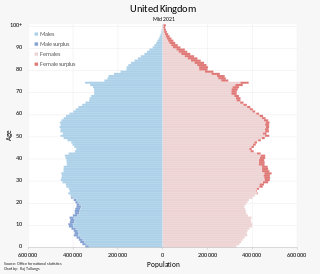
The population of the United Kingdom was estimated at 67,596,281 in 2022. It is the 21st most populated country in the world and has a population density of 279 people per square kilometre, with England having significantly greater density than Wales, Scotland, and Northern Ireland. Almost a third of the population lives in south east England, which is predominantly urban and suburban, with 8,866,180 people in the capital city, London, whose population density was 5,640 inhabitants per square kilometre (14,600/sq mi) in 2022.

County Antrim is one of the six counties of Northern Ireland, located within the historic province of Ulster. Adjoined to the north-east shore of Lough Neagh, the county covers an area of 3,086 square kilometres (1,192 sq mi) and has a population of 651,321, as of the 2021 census. County Antrim has a population density of 211 people per square kilometre or 546 people per square mile. It is also one of the thirty-two traditional counties of Ireland.

Lisnaskea is the second-biggest settlement in County Fermanagh, Northern Ireland. It is situated mainly in the townland of Lisoneill, with some areas in the townland of Castle Balfour Demesne, both in the civil parish of Aghalurcher and the historic barony of Magherastephana. It had a population of 3,020 people at the 2021 Census.

Bushmills is a village on the north coast of County Antrim, Northern Ireland. Bushmills had a population of 1,247 in the 2021 Census. It is located 60 miles (97 km) from Belfast, 11 miles (18 km) from Ballycastle and 9 miles (14 km) from Coleraine. The village owes its name to the River Bush and to a large watermill that was built there in the early 17th century. It is home to the Old Bushmills Distillery, which produces Irish whiskey, and is near the Giant's Causeway.

Castlederg is a town in County Tyrone, Northern Ireland. It lies on the River Derg and is near the border with County Donegal, Ireland. It stands in the townlands of Castlesessagh and Churchtown, in the historic barony of Omagh West and the civil parish of Urney. The village has a ruined castle and two ancient tombs known as the Druid's Altar and Todd's Den. It had a population of 2,980 people at the 2021 census.
Local government in Northern Ireland is divided among 11 single-tier districts known as 'Local Government Districts' and formerly known as district council areas (DCAs). Councils in Northern Ireland do not carry out the same range of functions as those in the rest of the United Kingdom; for example they have no responsibility for education, road-building or housing. Their functions include planning, waste and recycling services, leisure and community services, building control and local economic and cultural development. The collection of rates is handled centrally by the Land and Property Services agency of the Northern Ireland Executive.

Maghera is a small town at the foot of the Glenshane Pass in Northern Ireland. Its population was 4,235 in the 2021 Census. Formerly in the barony of Loughinsholin within the historic County Londonderry, it is today in the local-government district of Mid-Ulster.
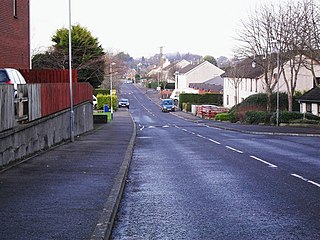
Carryduff is a small town and townland in County Down, Northern Ireland, about 10 kilometres (6.2 mi) south of Belfast city centre. It had a population of 7,173 people in the 2021 census. Most of the settlement lies within the townland of Carryduff, although part of it extends into the neighbouring townlands of Killynure and Mealough.

Newtownabbey is a large settlement north of Belfast city centre in County Antrim, Northern Ireland. It is separated from the rest of the city by Cavehill and Fortwilliam golf course, but it still forms part of the Belfast metropolitan area. It surrounds Carnmoney Hill, and was formed from the merging of several small villages including Whiteabbey, Glengormley and Carnmoney. At the 2021 census, Metropolitan Newtownabbey Settlement had a population of 67,599, making it the third largest settlement in Northern Ireland and seventh on the Island of Ireland. It is part of Antrim and Newtownabbey Borough Council.

Antrim is a town and civil parish in County Antrim, Northern Ireland. It lies on the banks of the Six Mile Water on the north-east shore of Lough Neagh. It had a population of 25,606 people in the 2021 census. It is the county town of County Antrim and was the administrative centre of Antrim Borough Council until its 2015 merger with Newtownabbey Borough Council to form Antrim and Newtownabbey Borough Council. The town lies 14 miles (23 km) north-west of Belfast.

Belfast City Council is the local authority with responsibility for part of Belfast, the largest city of Northern Ireland. The council serves an estimated population of 348,005 (2022), the largest of any district council in Northern Ireland, while being the smallest by area. Belfast City Council is the primary council of the Belfast Metropolitan Area, a grouping of six former district councils with commuter towns and overspill from Belfast, containing a total population of 579,276.

Artigarvan is a village and townland in County Tyrone, Northern Ireland.

Dollingstown is a large village in County Down, Northern Ireland, lying between Lurgan and Magheralin. It is within the Armagh, Banbridge and Craigavon district. In the 2011 Census it had a population of 2,103 people. Dollingstown is in the townland of Taughrane, which may come from Irish Tóchar Rathain.

Maguiresbridge is a small village in County Fermanagh, Northern Ireland. The village is named after the bridge over the Colebrooke River, first built by the local Maguire family about 1760. The village is 8 miles from Enniskillen and 3 miles from Lisnaskea.
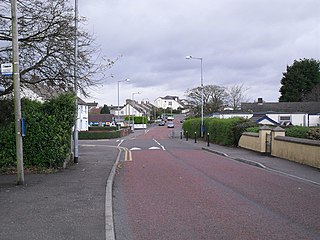
Moneyreagh or Moneyrea is a small village and townland in County Down, Northern Ireland. Around 6 miles (10 km) south-east of Belfast city centre, it is just off the main road between Belfast and Ballygowan. It is situated in the civil parish of Comber and the historic barony of Castlereagh Lower. It had a population of 1,594 people in the 2021 Census.
Christianity is the largest religion in Northern Ireland. In the 2021 census, 79.7% of the Northern Irish population identified as Christians: Catholic (42.3%); Presbyterian (16.6%); Church of Ireland (11.5%); Methodist (2.4%); Other Christian (6.9%). Meanwhile, 1.3% of the population belonged to other religions, 17.4% stated they were non-religious and 1.5% did not state a religious or non-religious identity. The Catholic Church has seen a small growth in adherents, while the other recorded Christian groups have seen a decrease.
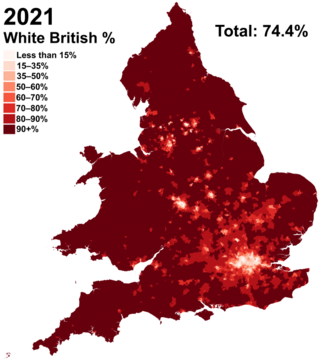
White British is an ethnicity classification used for the native White population identifying as English, Scottish, Welsh, Cornish, Northern Irish, or British in the United Kingdom Census. In the 2011 census, the White British population was 49,997,686, 81.5% of Great Britain's total population. For the United Kingdom entirely, due to different reporting measures within Northern Ireland which includes all those who identified as British with those who identified as Irish, an amalgamated total of 52,320,080 including those who identified as White Irish in Great Britain is given making up 82.8% of the population.
The Belfast metropolitan area, also known as Greater Belfast, is a grouping of council areas which include commuter towns and overspill from Belfast, Northern Ireland, with a population of 671,559 in 2011 and 704,406 in 2021. The area combines the Belfast, Lisburn, Newtownabbey, North Down, Castlereagh and Carrickfergus districts from before the local government reorganization of 2014. This equates to 37.1% of Northern Ireland's population.

Randalstown is a townland and small town in County Antrim, Northern Ireland, between Antrim and Toome. It has a very prominent disused railway viaduct and lies beside Lough Neagh and the Shane's Castle estate. The town is bypassed by the M22 motorway with junctions at both the eastern and western ends of the town. It had a population of 5,151 people in the 2021 census.

Northern Ireland is the smallest of the four parts of the United Kingdom in terms of both area and population, containing 2.9% of the total population and 5.7% of the total area of the United Kingdom. It is the smaller of the two political entities on the island of Ireland by area and population, the other being the Republic of Ireland. Northern Ireland contains 27.1% of the total population and 16.75% of the total area of the island of Ireland.